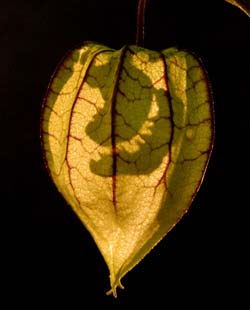Choice of food helps hungry caterpillar

Heliothis subflexa caterpillar on partially eaten fruit inside Physalis angulata calyx. <br>Credit: Penn State, Andrew Sourakov and Consuelo M. De Moraes <br>
For one caterpillar, eating an unusual fruit may be the key to an easy food supply and protection against parasites, according to a team of Penn State researchers.
The Heliothis subflexa caterpillar is a specialist herbivore that eats only the fruit of Physalis plants which include ground cherry, tomatillo and Chinese lantern. H. subflexa’s choice of food turns out to have unusual benefits in the three-way struggle between herbivores, their predatory wasps and the plants.
“We know that many plants produce volatile chemicals when chewed on by herbivores and that some of these chemicals attract wasps that parasitize the caterpillars,” says Dr. Consuelo M De Moraes, assistant professor of entomology. “However, when we investigated H. subflexa’s spit, it did not contain volicitin, a chemical elicitor that signals the plant to produce the volatile chemicals that attract wasps.”
H. subflexa somehow does not turn on the plant’s defenses.
“The co-evolution of plants, herbivores and their parasitoids is complex,” says Dr. Mark C. Mescher, assistant professor of biology. “We do not fully understand how the system is influenced by the interactions of the three players and we need to understand this to develop more environmentally friendly ways to deal with agricultural products and pests.”
Thinking the absence of elicitor was related to the caterpillar’s food, the researchers fed H. subflexa on a different food source and fed a different caterpillar on Physalis angulata. The Physalis-fed caterpillar did not produce the elicitor either, but H. subflexa, fed on a different food, did produce elicitors.
The researchers report in this week’s online edition of the Proceedings of the National Academy of Sciences that the Physalis angulata fruits used “lack linolenic acid.” Linolenic acid is necessary to produce the chemical in caterpillar spit that elicits the production of volatile wasp attracting substances.
Linolenic acid, however, is not just used to make the elicitor, but is a necessary chemical in the growth and maturation of many insects including other caterpillars and wasps.
“Physiologically, we do not know how the caterpillars manage to survive without it in their diet,” says Mescher. “It is a process of specialization and we plan to look at this next.”
The absence of linolenic acid explains why H. subflexa is the only caterpillar that feeds on Physalis. Other caterpillars forced to feed on the fruit rarely survived and those that did were often deformed. By somehow adapting to the lack of linolenic acid, H. subflexa manages to secure a food supply that only they can eat.
Physalis is characterized by a fruit enclosed in an inflated calyx, forming the Chinese lantern or husk tomato type of fruit. The caterpillar carefully bores a small hole in the calyx because, unlike the fruit, the leaves and flowers of the plant do produce linolenic acid. Caterpillars will often squeeze out of the same hole, even though they have grown.
“A caterpillar will eat three or four fruits during its lifetime,” says De Moraes. “Because they are protected by the calyx when feeding, the caterpillars are most likely to be parasitized when moving from one fruit to another.”
The absence of linolenic acid in the fruit appears to be passed on to caterpillar. Wasp larvae cannot develop within the caterpillar and so H. subflexa avoids becoming a home for wasp larvae.
The researchers note that the ability of H. subflexa larvae to develop without linolenic acid seems to give them almost exclusive access to Physalis fruit. H. subflexa can also exploit the protection from predators provided by the fruit’s calyx. Combining that protection with the protection afforded by an absence of linolenic acid for parasite development, H. subflexa has a very low level of parasites compared with other caterpillars.
By adapting to a fruit that no other caterpillar wants, H. subflexa has found a niche where life is good. An uncontested food supply, a way to eat the fruit without calling up the plant’s defenses and immunity to parasites make for successful caterpillars.
This work was supported by the National Research Institute of the U.S. Department of Agriculture, the Beckman Foundation, and a David and Lucille Packard Young Investigator Award.
Media Contact
More Information:
http://www.psu.edu/All latest news from the category: Life Sciences and Chemistry
Articles and reports from the Life Sciences and chemistry area deal with applied and basic research into modern biology, chemistry and human medicine.
Valuable information can be found on a range of life sciences fields including bacteriology, biochemistry, bionics, bioinformatics, biophysics, biotechnology, genetics, geobotany, human biology, marine biology, microbiology, molecular biology, cellular biology, zoology, bioinorganic chemistry, microchemistry and environmental chemistry.
Newest articles

An Endless Loop: How Some Bacteria Evolve Along With the Seasons
The longest natural metagenome time series ever collected, with microbes, reveals a startling evolutionary pattern on repeat. A Microbial “Groundhog Year” in Lake Mendota Like Bill Murray in the movie…

Witness Groundbreaking Research on Achilles Tendon Recovery
Achilles tendon injuries are common but challenging to monitor during recovery due to the limitations of current imaging techniques. Researchers, led by Associate Professor Zeng Nan from the International Graduate…

Why Prevention Is Better Than Cure—A Novel Approach to Infectious Disease Outbreaks
Researchers have come up with a new way to identify more infectious variants of viruses or bacteria that start spreading in humans – including those causing flu, COVID, whooping cough…



